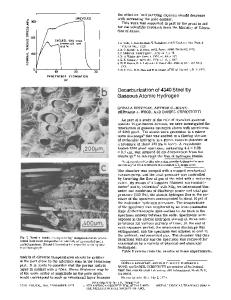Porosity nucleation in metal-matrix composites
- PDF / 223,469 Bytes
- 6 Pages / 612 x 792 pts (letter) Page_size
- 18 Downloads / 393 Views
I. INTRODUCTION
THE production of porosity-free metal-matrix composites (MMCs) remains a technical challenge due to the complexity of the underlying mechanism of defect formation. The specific process under consideration involves infiltrating a ceramic preform with the matrix and solidifying it to produce a composite casting with enhanced mechanical and thermal properties over traditional engineering materials. The porosity in such casting is generally believed to be due principally to (1) solidification shrinkage occurring when the pressure gradient is insufficient to overcome the resistance offered by dendritic networks to feed voids, (2) precipitation of dissolved gas in the melt, (3) gas entrapment due to incomplete evacuation of the preform during infiltration, and (4) preporosity due to incomplete infiltration. Other factors can be surface roughness, interface wetting, reaction, and so on. This article examines the fundamental mechanism of porosity nucleation in a hypothetical casting that has been thoroughly cleaned and degassed. This allows isolation of the contribution of shrinkage pressure to porosity nucleation at this stage. The literature on porosity formation in unreinforced metals or alloys[1–5] and in powder technology[6,7] is rather extensive, while relatively little has been done on reinforced castings produced by infiltration processing. A recent study on SiC/Al2O3 particulate-reinforced MMC[8] attributed porosity formation to the solidification rate and metal feeding. The microporosity observed in the 359/SiC(p) composites studied was attributed to pore nucleation at the SiC particulate sites and to hindered liquid metal flow due to particle clustering. The former factor was thought to be responsible for the skewed porosity distribution profiles typically observed in these composites. In 359/Al2O3 composites, however, the limited feedability and wider freezing range of alloy or the larger particle sizes of alumina resulted in bell-shaped porosity distribution as well as large maximum pore sizes. For the MMCs produced by infiltration, OLUSEGUN J. ILEGBUSI, Professor, is with the Department of Mechanical, Industrial and Manufacturing Engineering, Northeastern University, Boston, MA 02115. JIJIN YANG, formerly Postdoctoral Student, Department of Mechanical, Industrial and Manufacturing Engineering, Northeastern University, is Software Engineer with Nortel Networks Corporation, Billerica, MA 01821. Manuscript submitted July 19, 1999. METALLURGICAL AND MATERIALS TRANSACTIONS A
poor wettability at the matrix/reinforcement interfaces and complexity of reinforcement configurations may result in porosity at moderate (e.g., 10 MPa[9]) to relatively high (e.g., 100 MPa) pressures.[10] Porosity due to solidification shrinkage has been reported in fully degassed particulatereinforced MMCs.[11] In general, heterogeneous nucleation of pores is believed to be more energetically favorable than homogeneous nucleation, on a nonwetting interface.[12] However, evidence suggests that porosity does not readily nucle
Data Loading...










